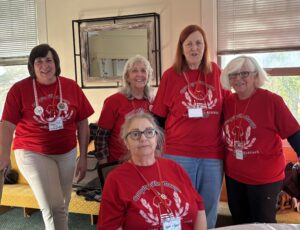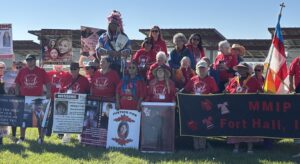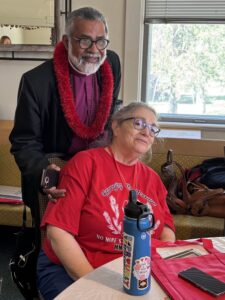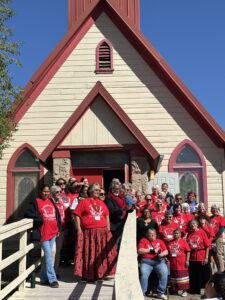Fry bread — that staple made of the simple ingredients once rationed to Native people during U.S. government-forced relocations to reservations — was both a metaphor and on the menu for “Acknowledging the Sacred Ones,” a Sept. 26-28 Province VIII Episcopal Church Women’s retreat at Good Shepherd Church on the Shoshone Bannock Reservation in Fort Hall, Idaho.
“It (fry bread) comes out of colonial heritage,” said the Rev. Rachel Taber-Hamilton, former vice president of The Episcopal Church House of Deputies, who addressed the gathering attended by more than 50 women lay leaders from Los Angeles, Navajoland, Washington, Oregon, Arizona, Hawaii, Utah, Idaho, Nevada and Alaska. The three-day retreat focused on the disproportionately high numbers of murdered and missing Native people, The Episcopal Church’s involvement in residential boarding schools, and the Doctrine of Discovery.
Although the bread, made of flour, baking powder, salt, lard, “comes out of a sense of want … just like Indigenous people seem to do everywhere, we take what we get, and we make a blessing. We find a way to find joy in coming together in this community,” said Taber-Hamilton, a member of the Shackan First Nation Community of Canada and the rector of Trinity Church in Everett, Washington.
“Fry bread has gone from being a symbol of oppression, to being something that brings people together,” she said. “To me, that’s transformative. And it’s the work that we need to be doing right now in our relationships … transforming fry bread into how we understand that we live together as a living Body of Christ. None of us can change the past. All of us can change the future.”
Idaho Bishop Jos Tharakan also addressed retreat participants, commending the work of the ECW, adding that “church is about recognizing people, loving people. It is to learn how to live on the other side. It is why we are here.”
Although the diocese struggles for resources, Good Shepherd Church, once the site of a residential boarding school, is a vibrant community under the spiritual leadership of lay vicar Ron Braman (Eastern Shoshone), Tharakan said. “It is absolutely beautiful to worship together here … it’s very real, it’s very raw, it’s very personal, it’s very beautiful. I’m grateful for that community and it is worth us expanding that knowledge to the rest of the world around us.”
Christine Budzowski, Los Angeles diocesan ECW president and provincial ECW secretary and treasurer, told The Episcopal News she “learned a lot and was moved to tears, listening to some of the stories” of missing and murdered Native people, and of those who were taken from their parents as children and confined to residential boarding schools. She also said that a similar ECW gathering may come to Los Angeles next year, with more information available at the upcoming Nov. 7-8 meeting of diocesan convention.
Carrying the message of stolen lives
Retreat participants, wearing red T-shirts declaring, “Carrying the Message: No More Stolen Relatives” also participated in the Sept. 27 Shoshone Bannock Reservation’s “Indian Days” celebration, joining Good Shepherd Church’s parade float, which won first prize for its creativity.
Stolen lives and the resultant ongoing intergenerational trauma were recurring themes as guest speaker Melissa Bird, a descendant of the Shivwits Band of Paiutes, and a nationally recognized lay preacher, author, life coach and social worker, as well as other speakers addressed the gathering.
Bird, a candidate to represent Oregon’s 4th Congressional district, linked government tactics historically used against Native peoples with current treatment of “our immigrant relatives, some of whom are also Indigenous.
“We are in outrage, watching in real time,” Bird said, referring to the current federal administration’s removal of undocumented persons. “Families are being disappeared with no evidence of their whereabouts. That leaves many of us, as Native people here, to wonder when will we ever gain the level of attention to the crisis that is happening. Native families, the disappearing of brown people, is the legacy of the United States of America. This is the legacy of colonization, hundreds of years of erasing the original stewards of this land.”
Federal and local law enforcement agencies in recent years have declared a crisis, the rate of missing and murdered Native people and violence against Native people estimated to be at least ten times higher than in the general population. A 2016 study by the National Institute of Justice (NIJ) found that more than four in five American Indian and Alaska Native women (84.3 percent) had experienced violence in their lifetime, including 56.1 percent who have experienced sexual violence. And many crimes go unreported, or are sometimes complicated by lack of investigative resources and the misidentification of Native people in other racial categories.
“For decades, Native American and Alaska Native communities have struggled with high rates of assault, abduction, and murder of tribal members,” according to the U.S. Department of the Interior Bureau of Indian Affairs website. “Community advocates describe the crisis as a legacy of generations of government policies of forced removal, land seizures and violence inflicted on Native peoples.”
Willeena George (Shoshone-Bannock) and her spouse Paul Frank (Yakima), organizers of the Fort Hall-based “Carrying the Message” advocacy group, told the gathering of their efforts to support families and to find justice for missing and murdered Native people. George lost a son to suicide and remains unconvinced that the death of her niece, Samantha Bear, was accidental, as determined by local authorities.
Many Native families have similar stories, according to Bird. “It is said that my great-great-grandmother was murdered in a cave in southern Utah. She was forced into the cave with about 25 other people from our tribe, and the cave was blown up, and they were trapped. All of them perished,” she said.
“It is said that my great-great-grandfather was forced into slavery,” she added. “We have no idea where he died. We just know it was somewhere in the desert. My great grandmother was originally called Sadie when she was sold to a polygamous family for a mule. She was around eight years old. She did housework. They changed her name. She was forced to learn English and was baptized by Mormons in 1896. I did not learn any of these things until about a decade ago.”
Erasing the culture led to intergenerational trauma, she said. “My father took his own life when I was six years old. My story is not unusual. It is the story of colonization. My entire history was erased because of a long legacy of stolen lives, forced removals and silenced voices. All of us as Native people have these stories. They are regular, everyday occurrences in our world since the white folks came.”
Residential boarding schools
Athabascan Native Pearl Chanar recalled being taken from her Minto, Alaska, home as a teenager and placed in a residential boarding school where she and other young girls were forbidden to speak their language or honor their culture. They were only able to communicate with family through letters. “What I remember most is the loneliness, missing my parents,” she said.
“I wanted to get up and walk out of the room,” when reliving her experience as retreat participants viewed “Native Voices: Speaking to the Church and the World”, a film produced by The Episcopal Church Office of Indigenous Ministry, in which she was featured, Chanar told The Episcopal News.
More than 3,100 students died at the boarding schools, more than three times the number documented by the government, according to a 2024 Washington Post report. Good Shepherd Church also operated a residential boarding school, one of several in the Fort Hall area, Braman said.

The L.A. delegation, from left, Tammy Smecker-Hayne (diocesan UTO coordinator and member of St. Andrew’s, irvine); Martha Estes (past diocesan and provincial ECW President, and member of St. Columba Spirit of Peace, Big Bear), Christine Budzowski (diocesan ECW President and Provincial Secretary-Treasurer, and member of St. Luke’s, Long beach), and former L.A. diocesan delegate Linda Hughes (now in Oregon), Seated, Barbara Harris (Trinity, Redlands)
Doctrine of Discovery
Taber-Hamilton said the Doctrine of Discovery, used to colonize and subjugate non-Christian people, is not unlike the Christian nationalism prevalent today,
which seeks to fuse Christian and national identities and rejects the separation of church and state.
“It (the Doctrine of Discovery) is a set of international laws and principles informed by the European world view, which was in turn formed by a particular Christian theology and beliefs of the 15th and 16th centuries. This is haunting us right now,” she said.
“It also indoctrinates a set of racist principles based on the theological foundation that Christian nations are exceptional, with divinely endowed rights, while non-Christians and nonwhites are inferior and not entitled to the same civil rights.”
The Episcopal Church led the way as the first Christian body to repudiate the Doctrine of Discovery through an act of General Convention in 2009 and offers educational and other resources.
In 2012, then Presiding Bishop Katharine Jefferts Schori called for healing and cooperative efforts to dismantle those existing structures and policies. In a pastoral letter to the church, she said, in part, “The legacy of domination includes frightful evil—the intentional destruction of food sources and cultural centers like the herds of North American bison, the intentional introduction of disease and poisoning of water sources, wanton disregard of starvation and illness, the abuse and enslavement of women and children, the murder of those with the courage to protest inhumane treatment, the repeated dispossession of natural
resources, land, and water, as well as chronically inadequate Federal management and defense of Native rights and resources.”
Taber-Hamilton said: “I’ve heard young people say, ‘you know, things have changed. We’ve just got to deal with it. Why can’t you get over it?’ And what I hear elders responding is, ‘it’s still very much with us, and we need to remember it and do the honoring and know that history, because so many people don’t’.”
Good Shepherd’s lay vicar and spiritual leader Braman said the stories must be shared and honored because “this stuff has a way of living in our bones, and learning about it is how we release it and get healed.”



